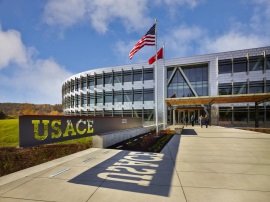
by Brianna Crandall — May 15, 2015—In addition to this year’s Top Ten Green Projects the American Institute of Architects (AIA) and its Committee on the Environment (COTE) have selected the U.S. General Services Administration’s (GSA) Federal Center South Building 1202 in Seattle as the recipient of the Top Ten Plus award, which recognizes one past Top Ten award recipient that has quantifiable metrics that demonstrate the true impact the sustainable design has achieved.
The U.S. Army Corps of Engineers Seattle headquarters, designed by ZGF Architects LLP and built by Sellen Construction, was highlighted as an example of reducing operating costs, saving taxpayer money, and providing healthier work space for a federal agency. This 2013 Top Ten award winner’s energy savings and other sustainable design aspects have been verified over the past year of operation.
Part of the 2009 American Recovery and Reinvestment Act, the new building transformed a previously toxic brownfield into a new standard for a high-performance, cost-effective and sustainable workplace. Atypically for most government projects, the design and construction of the headquarters was completed in just 31 months as part of a rapid project delivery model—on time and within the original $72 million budget.
Following a one-year measurement and verification period, the building’s energy performance is meeting the goal of a 30 percent improvement on the ASHRAE 90.1 benchmark for U.S. commercial building energy codes. The facility’s metered energy performance has reportedly met every design target, including the contractually required energy performance and the AIA 2030 Commitment. At the end of last year, the Federal Center South building was using 61% less energy than the national average for similar buildings and 46% less water than a current plumbing code-defined baseline, points out AIA.
To further enhance the building’s sustainable performance, the team developed, tested and evaluated enhancements to the base design during the design and construction of the project so that GSA could incorporate upgrades into the project as funding became available. Through this process, the team was able to add rainwater harvesting, a geothermal system, enhanced lighting controls, an energy dashboard and improved glass in the main skylight.
AIA notes that this project was designed to meet GSA’s requirement for a building with a 50-year minimum lifespan, and mechanical equipment that lasts a minimum of 20 years. The campus site can also reportedly accommodate the 30-year expansion and redevelopment requirements for a number of federal agencies.




